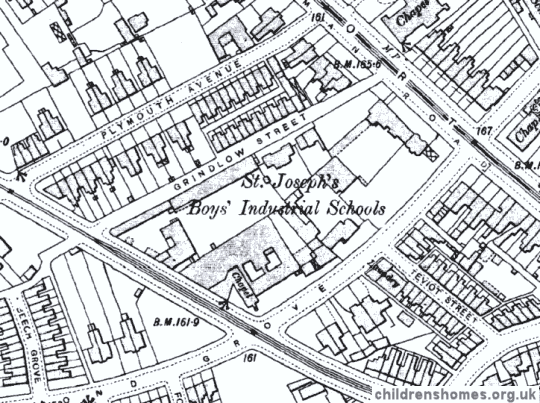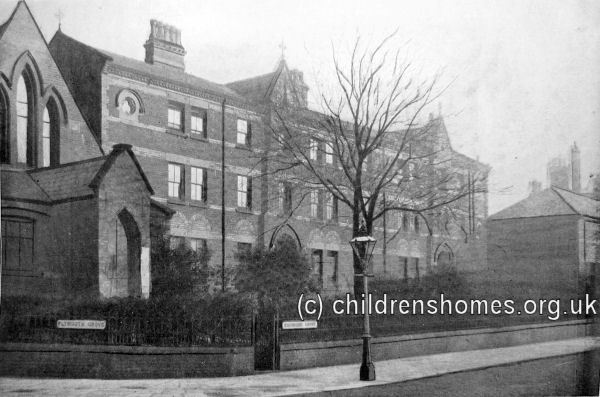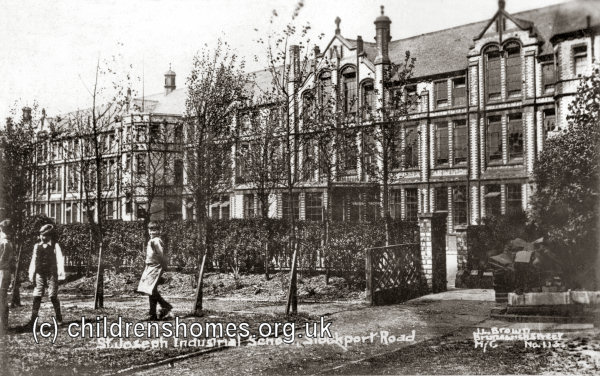St Joseph's Industrial School for Roman Catholic Boys, Manchester, Lancashire
St Joseph's Industrial School for Roman Catholic Boys was founded by Father Thomas Quick. According to an article in the institution's magazine, the Jospehian, published in 1908, Father Quick was moved to establish the School after a poor Catholic widow whom he was attending on her deathbed begged him to protect her three young children from losing their Catholic faith.
On June 14th, 1871, the School was certified to accommodate up to 350 boys, aged from 10 to 16 at their date of admission, in premises at 8 Richmond Grove, Longsight, Manchester. Part of the site, which was off the main Stockport Road, also housed St Joseph's Industrial School for Girls.
The location of the School is shown on the 1908 map below.

St Joseph's Industrial School for Roman Catholic Boys site, Manchester, c.1908.

St Joseph's Industrial School for Roman Catholic Boys, Manchester, from the south, c.1908. © Peter Higginbotham
The boys' industrial training included tailoring, shoemaking, joinery and baking, while the younger boys were engaged in matchbox manufacture and sock-making. All the boys assisted in the work of the house and in the kitchen and laundry. The School also had a large band.
In April 1876, following complaints by some of the parents of children at the School, a sub-committee of Manchester's Industrial Schools Committee, visited the establishment and found conditions there to be far from satisfactory. A large number of the boys were found to be affected with sore eyes, and their physical appearance was, the whole, unsatisfactory, there being apparent want of robustness, especially amongst the younger boys. A closer examination of two boys whose parents had complained, revealed that their hair and clothing were thickly infested with vermin, and there was general want of cleanliness in their personal condition. The bedding in the boys' dormitories was found to be swarming with fleas, and some of the linen was in a very dirty state. In the sick ward there were five boys, but they were all out of bed dressed. They were suffering from complaints of different characters. There was no special attendant for the sick room, and the boys, one of whom seemed in a very weak state, were passing their time listlessly. They were all standing as there was not seat of any kind in the room, nor any furniture except the beds. It was also discovered that the boys were sent out every Saturday afternoon to collect money in aid of the institution, and that they were in the habit of going for money to public-houses. The girls in an adjoining room presented a better appearance than the boys, but were found to be suffering from vermin in their heads. One girl sent by the Salford School Board was in bed, apparently in dying state, and in the same room were four convalescent girls. The condition of the school was declared by several members of the Board to be a disgrace to civilisation, and the leading Roman Catholic member, Dr. Somers, said he felt overpowered with shame at the revelations which had been made. It was resolved to request the Home Office to send a Government Inspector to visit the school as early as possible. The requested inspection took place about ten days later and found that although 'there did exist some necessity for greater cleanliness', the complaints 'seemed scarcely borne out' by what the Inspector found.
An inspection in 1881 noted that the staff at the School comprised the Rev. Quick, assisted by Mr Maher, a tailor, a shoemaker, and 15 untrained voluntary assistants — an arrangement which he felt was unsatisfactory. The criticism was accepted by Quick and the use of voluntary workers was ended. A year later, the Inspector recorded that the staff now comprised the Rev Thomas Quick as manager and chaplain,; schoolmaster, Mr A O'Callaghan; superintendent, Mr S Reynolds; store and book-keeper, two work-masters, box and shop master, cook and assistant cook, dormitory nurse, infirmary nurse, tailor, shoemaker, baker, joiner, and bandmaster.
In June 1882, part of the School premises at 6 Richmond Grove were made into a Home for Working Boys. The Home housed up to 50 boys, aged from 14 to 16, who had begun working for local employers prior to their discharge from the School. Mr and Mrs Keating were appointed as the Home's first Master and Matron.
In 1884, the Girls' School moved to new premises at Victoria Park. The Longsight premises were then divided into senior and junior sections. The junior section occupied the former girls' quarters and could house 100 boys up to the age of 11.
The Rev. Quick retired from the management of the School at the end of 1885. From that date, the establishment was run by the Brothers of the Christian Schools. Under the Brothers, changes were made in the School regime and the buildings were considerably improved. The range of industrial training activities was extended, with the addition of tin-smithing, woodcarving, cabinet making, plumbing, mechanics and machine-knitting. A fife and drum band was established for the junior boys.
In around 1912, there was a major rebuilding of the premises with a long range being constructed along the length of Grindlow Street at the north of the site.

St Joseph's Industrial School for Roman Catholic Boys, Manchester, from the east, c.1920. © Peter Higginbotham
The School's Auxiliary Home was closed in February, 1929.
In 1933, St Joseph's became an Approved School, one of the new institutions introduced by the 1933 Children and Young Persons Act to replace the existing system of Reformatories and Industrial Schools. It was designated as an Intermediate Approved School, housing up to 300 boys aged 13 to 15. At the start of the Second World War, the School relocated to premises at London Road, Nantwich.
From 1939 to 1948, the Longsight building was used by the fire services. In 1948, the site was taken over by the Manchester Police as a divisional headquarters and transport depot. The site is still occupied by the police but all the old School buildings have now been replaced.
Records
Note: many repositories impose a closure period of up to 100 years for records identifying individuals. Before travelling a long distance, always check that the records you want to consult will be available.
- Cheshire Archives and Local Studies, Cheshire Record Office, Duke Street, Chester, Cheshire CH1 1RL. Holdings include: Admission registers (1871-1957); After-care records (1922-1965); Lists of boys discharged (1928-1940); Approved School licensing registers (1947-1970); Correspondence and papers relating to pupils (c.1879-1964); Rules for Management and Discipline (1924); Photographs (1945-1954).
Census
Bibliography
- Higginbotham, Peter Children's Homes: A History of Institutional Care for Britain's Young (2017, Pen & Sword)
- Mahood, Linda Policing Gender, Class and Family: Britain, 1850-1940 (1995, Univeristy of Alberta Press)
- Prahms, Wendy Newcastle Ragged and Industrial School (2006, The History Press)
Links
- None noted at present.
Except where indicated, this page () © Peter Higginbotham. Contents may not be reproduced without permission.


